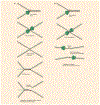Repair of genomic interstrand crosslinks
- PMID: 39106540
- PMCID: PMC11423799
- DOI: 10.1016/j.dnarep.2024.103739
Repair of genomic interstrand crosslinks
Abstract
Genomic interstrand crosslinks (ICLs) are formed by reactive species generated during normal cellular metabolism, produced by the microbiome, and employed in cancer chemotherapy. While there are multiple options for replication dependent and independent ICL repair, the crucial step for each is unhooking one DNA strand from the other. Much of our insight into mechanisms of unhooking comes from powerful model systems based on plasmids with defined ICLs introduced into cells or cell free extracts. Here we describe the properties of exogenous and endogenous ICL forming compounds and provide an historical perspective on early work on ICL repair. We discuss the modes of unhooking elucidated in the model systems, the concordance or lack thereof in drug resistant tumors, and the evolving view of DNA adducts, including ICLs, formed by metabolic aldehydes.
Keywords: Cancer chemotherapy; DNA repair; Drug resistance; Interstrand crosslink; Unhooking.
Published by Elsevier B.V.
Conflict of interest statement
Declaration of Competing Interest The authors declare no competing interests.
Figures






References
Publication types
MeSH terms
Substances
Grants and funding
LinkOut - more resources
Full Text Sources

